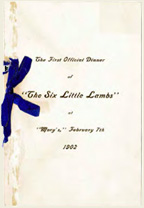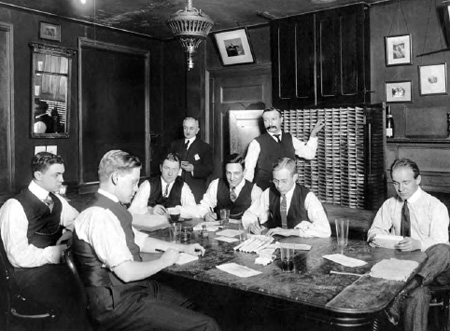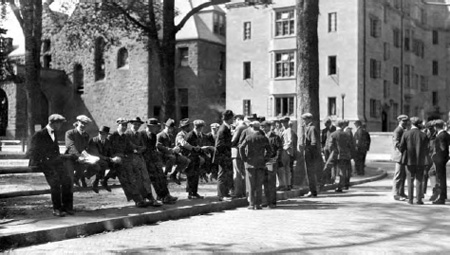The following history was written by Charles Buck ’69 and Robert Birge ’68 for inclusion in The Twentieth Century Project. a two-volume bookset authored by Richard “Dog” Gould ’68. Volume II * Whiffenpoofs – Twentieth Century * presents the most complete compilation of Whiffenpoof history available.
The Reverend James Merriam Howard wrote his ‘authentic’ history of the founding of the Whiffenpoofs for the 50th Whiffenpoof anniversary to set the record straight about how the Whiffenpoofs began and how The Whiffenpoof Song was created. Howard’s recollections are more than just a factual account. He created a genuinely intimate and detailed portrait of day-to-day life at Yale that might otherwise have been unavailable to us. In fact, his brief history gives us perspective on and insight into the 1907-10 period that we have yet to find for any later period up to World War II.
As remarkable as Howard’s description of Whiffenpoof origins may be, another contemporary source, from 1906, should be considered:
…the only organized effort at singing at Yale was a large choral society, taking into its membership those who could sing at all reasonably, without being especially scrupulous that they should be good and available singers; and practicing only heavy and serious compositions. About this time it occurred to some of the undergraduates that the habit among the students of singing their college songs in on offhand way in their rooms, on the Campus, and on the street, might be utilized and developed by the formation of a small club, which should practice together in order to do the same things with more finish, add to them other light and catchy songs, and sing them for the public enjoyment. The first attempt of this kind that was substantial and successful was made when about eight voices met with some degree of regularity and learned, besides many of the old songs commonly about the Campus, a few additional pieces of the some character.
-The Yale Glee and Banjo Clubs: A History (Bartholomew Archive)
The group described is not the Whiffenpoofs, but the Yale Glee Club, and the year referred to is 1867. The quotation comes from a promotional piece prepared for the Glee Club’s 1906 Christmas vacation trip. This source parallels Howard’s account, but looks back half a century to the origins of what was then considered informal singing, except that the Glee Club was then the new informal singing group.
This account reveals that the Whiffenpoofs emerged from a tradition of singing in America, epitomized by the male quartet, that was already more than fifty years old. Marshall Bartholomew ’07s, in his unpublished manuscript A History of Music at Yale, remarked “the male quartet became a regular feature of Yale Glee Club concerts soon after the Civil War.” Even before the first Yale Glee Club was formed, close harmony had made its appearance on the Yale campus, as he records:
In 1856, for example, there were informal singing groups which took fanciful titles unto themselves, as similar groups do at present [the 1950s]. We find the Beethoven Bummers – evidently poking fun at the more serious Beethoven Society; also there were the Owls and the Four Sharps.
 This tradition continued into the 1880s with other groups including the Midnight Caterwaulers of 1870 (a quintet), the Singing Club of 1872 (a quartet), the Crows of 1872 (an octet), and the Offenbachanalians of 1874 (a quartet). The Beethoven Bummers lasted into the 1870s with as many as fifteen singers.
This tradition continued into the 1880s with other groups including the Midnight Caterwaulers of 1870 (a quintet), the Singing Club of 1872 (a quartet), the Crows of 1872 (an octet), and the Offenbachanalians of 1874 (a quartet). The Beethoven Bummers lasted into the 1870s with as many as fifteen singers.
Howard’s account understandably ignores the roots of informal singing in the 19th century. Even so, it begins far too late: the Whiffenpoofs did not in fact begin with the well-known gathering of five singers in 1909, but as early as 1902, when a group of Glee Club members calling themselves the ‘The Six Little Lambs’ sang their own version of Gentlemen-Rankers, the song that would soon be transformed into The Whiffenpoof Song. Carl Lohmann recalled the group in a letter to Austin Bruff, a member listed on the invitation to The First Official Dinner of ‘The Six Little Lambs’ at Mory’s, February 7, 1902:
All my correspondence is now with Bee Van Vetchten including a menu of the first dinner held by the ‘Six Little Lambs’ at Mory’s which Buff [Kimball] loaned me… It seems to me that the ‘Six Little Lambs’ might have grown to be what the Whiffenpoofs are today only, unfortunately, it was allowed to die out instead of passing on from class to class.
Kipling’s Gentlemen-Rankers remained popular throughout the first decade of the 20th century at Yale and was known to have been sung at Class Day exercises in 1908. The following 1908 New York Herald account of the Yale Glee Club’s western trip during the Christmas holidays also shows that a lamb-inspired version of Gentlemen-Rankers was sung by Glee Club members before the song acquired its Whiffenpoof lyrics.
During this decade undergraduates with a love for harmonizing formed a cappella groups that just as quickly disbanded when their members graduated. These groupsincluded the Growlers, who immediately preceding the Whiffenpoofs, and the CupMen and Hogans, their contemporaries, with whom the founding Whiffenpoofs freely associated musically. Although there is now a difference of opinion about the function of these groups, any excuse for good singers to gather was sufficient to generate apparently high-quality music making.

To appreciate the quality of the first Whiffenpoof group, it is important to set a musical context for its founding. By this time, singing at Yale had already become more than a pastime; it was then the most popular extra-curricular activity on campus. In 1909, the total undergraduate population numbered only 2,198, including Yale’s Sheffield Scientific School, a three-year institution that, notwithstanding the lower status it was accorded compared to Academic, participated fully in the musical life at Yale. Each class had an identity that was reinforced by frequent singing, generally spontaneous, at its portion of the Fence, the traditional gathering point originally on the corner of Chapel and College Streets. When Osborne Hall was built on this site, a new Fence was erected within the campus itself.
This account of Glee Club tryouts shows the popularity of singing in 1906:
At the beginning of each college year, in order to fill vacancies made by those who have graduated or those who have been adjudged not worthy of being reinstated, competitive examinations are held at which two hundred or more applicants are canvassed to fill possibly ten or fifteen vacancies… The direct result of these very exacting competitions is to induce the students to prepare for them in advance by training under good teachers, and thus the standard of the applicant is raised to a far higher point than if they were merely untutored musicians.
Marshall Bartholomew recalls Carl Lohmann’s tryout with uncharacteristic awe:
Lohmann’s voice trial remains unforgotten amid thousands of similar trials that have been since then. Asked to vocalize a few scales upward this mellow, well-modulated voice sang up to and including a robust tenor F. ‘Hmm,’ commented the director, ‘Good tenor material here.’ Then he ran the candidate downward in arpeggios. Down, down, down, down, to a good E-flat in profundo, also with good quality and volume. Here was material for a one-man quartet with range enough to sing any part and the quality of a ready-made soloist.
All the while, the Glee Club performed works in an intentionally popular vein, as documented again in the 1906 promotional history:
[In preparing for the 1906 Christmas trip] the management has decided to omit all choruses of a technically difficult and pretentious character, and fill the programme entirely with light, cheerful, jolly songs that will give each audience a genuine good time. There will be new songs of an airy, dainty character; new humorous numbers for the chorus; new solos for the individual singers; new ‘stunts’ for the funny men; but there will also be a liberal selection of the old standard songs which appeal to the Yale spirit, which call up the memory of happy days, which disclose the special character of college life and which raise anew the thrill of pride in the mother university.
These performances featured the Varsity Quartet, soon to become the Whiffenpoofs.
First, the group intended, from the start, to establish an ongoing institution, as shown by the drafting of an immutable constitution and the agreement, weather permitting, to sing publicly on a regular schedule.
Second, it had a bona-fide theme song, adapted from a popular tune and lyrics of the time, but assimilated by the group as a distinguishing feature (the song could be sung only at Mory’s).
Last, but not least, the group set a standard by the quality of their singing, amply corroborated by the reports of their contemporaries and the popularity of their weekly singing at Mory’s, that made continuing the tradition worthwhile (three of its members – Lohmann, Minnigerode, and Pomeroy – were in fact juniors).
The thread connecting this activity, then, was a shared consciousness of this enterprise’s value, not only to its current members, but also to Yale singers that they might never know.


